Compulsion
Posted in: Uncategorized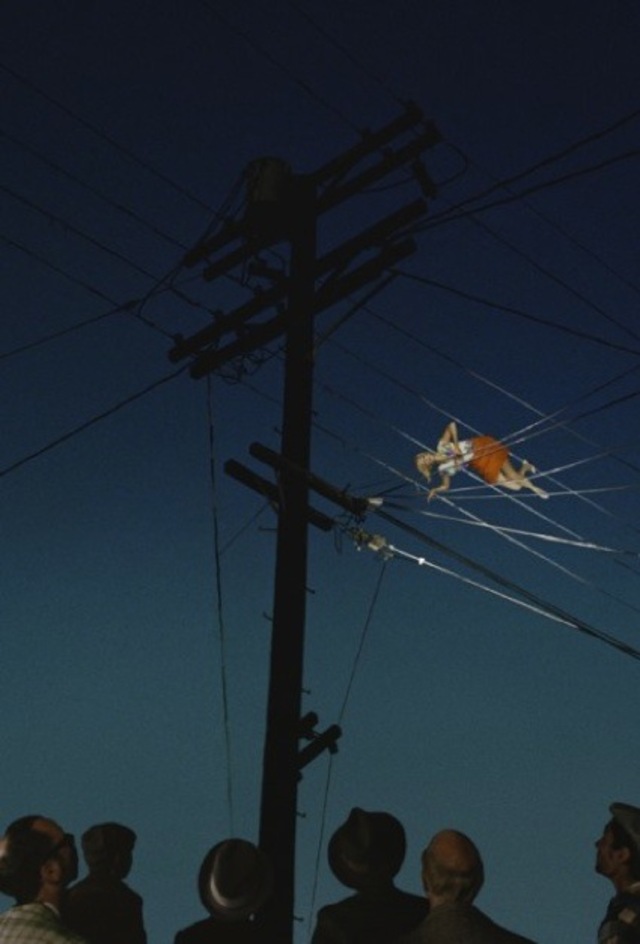


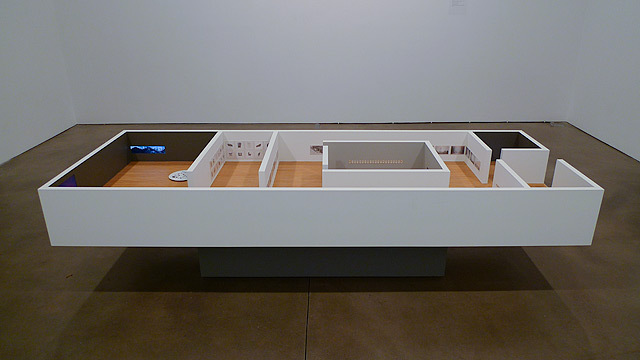
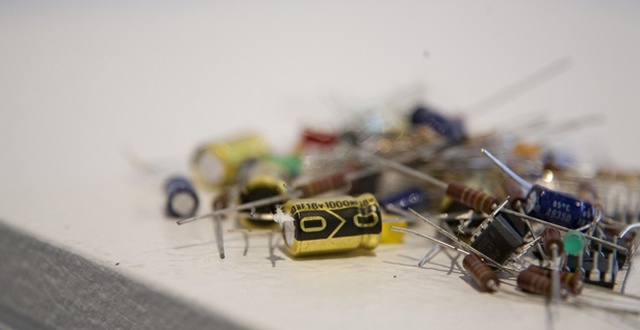
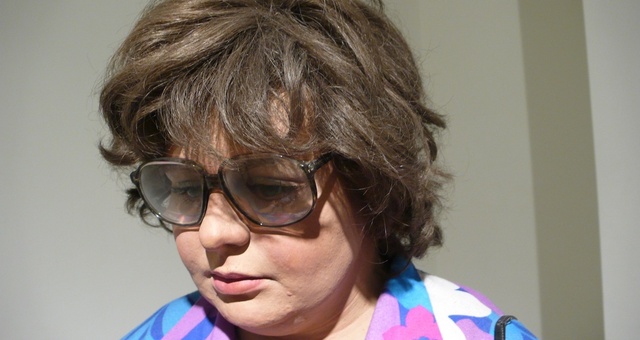
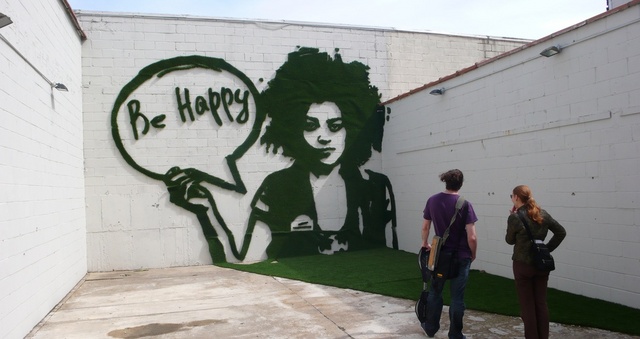
About time to finish off my reviews of New York art shows. Only two left. One is over -but god was it good, the other one runs until June 21.
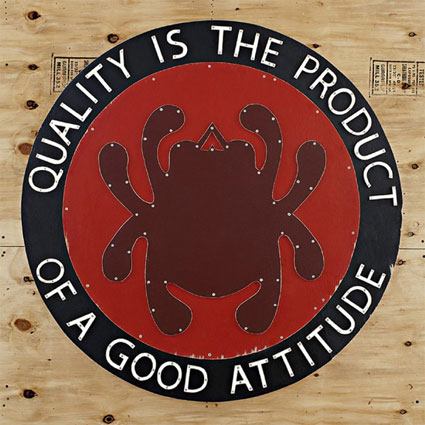
Quality, 2008
The one exhibition i could not miss was Tom Sachs’ lineup of new works at the Sperone Westwater. The show is called Animals so there’s a fair amount of pieces which explore the presence of the animalistic in our everyday lives but there’s also some quirky machines and installations.
Sachs cultivates a trashy aesthetic. Each of his sculptures is hand made by piecing together plywood, foamcore, synthetic polymer paint, hardware, and found or scavenged objects such as phone books or police barricades. There’s no Prada Death Camp nor Chanel guillotine in the gallery this time but the titles and content of some of the works are nevertheless sure to get the public’s attention.
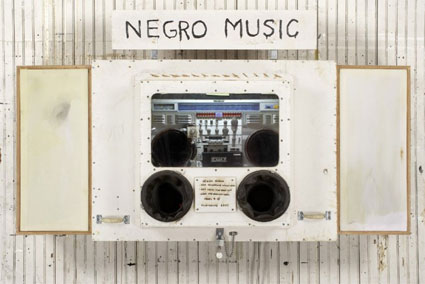
Negro Music, 2008
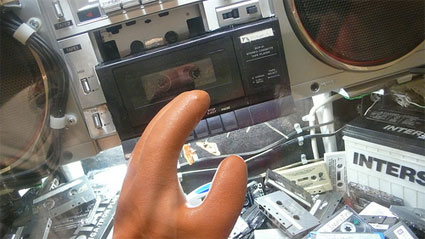
Detail of Negro Music
First there’s Negro Music which you could regard as interactive. It’s a big white-painted box with a retro gangsta-style boombox inside, you insert your hands inside orange rubber gloves, rummage inside the box, select a k-7 of your favourite “negro” music, fiddle with the control buttons and play the music as loudly as you wish inside the gallery.
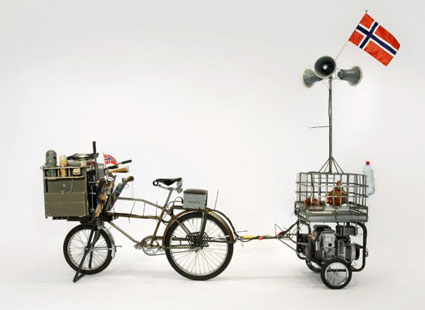
Waffle Bike, 2008
And Waffle Bike! Sachs has even crafted a mighty waffle-maker-bicycle, complete with a mini-fridge, a cage for chicken to lay fresh eggs as well as components to hold ingredients like whipped cream, and others we have never heard of in waffle-heaven Belgium like Pam cooking spray, and lingonberry jam.
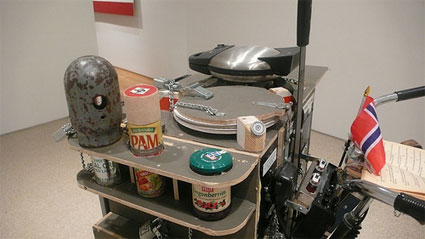
Detail of Waffle Bike
Hardcore is already the third in a series of large-scale gun chests inspired by Renaissance dueling cabinets. The huge cupboard is shockfull of handmade wooden guns along with the tools that were used throughout their fabrication.
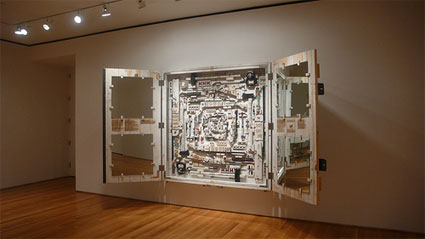
Hardcore, 2008
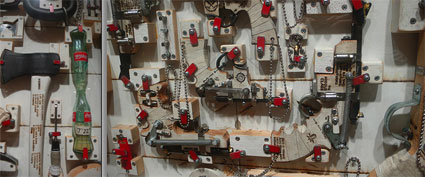
Details of Hardcore, 2008
Exhibiting these cabinets is not without a risk. As art on trial reports, Manhattan art dealer Mary Boone displayed one of them in her gallery back in 1999. The cabinet contained homemade guns but also a vase containing live 9-millimeter cartridges which visitors were invited to take as souvenirs. Ms. Brown was arrested by the police and charged with unlawful distribution of ammunition. When it was determined that the homemade guns were functional, police added unlawful weapons possession charges.
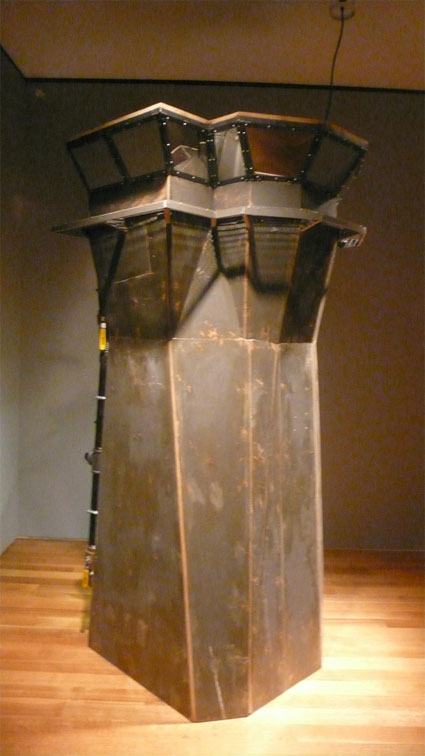
Then there are the Animals which give the tile to the show. There’s a couple of installations made to please some of them such as La Guardia, an impressive tower for the exclusive use of cats and featuring a litter box requiring minimal cleaning chores, a McDonald’s that serves cat food, a Japanese Zen garden with a video of clouds and birds chirping, and a penthouse with a paw-operated catnip atomizing spray.
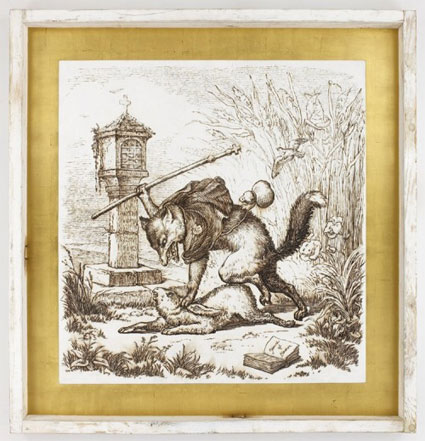
Hours of Devotion, 2008
There’s a white whale on a black piano and a tiger lamp. Most of the show is just good old Sachs fun, bricolage and subversion. The public loves it so why should Sachs change the magical formula?
The real surprise (at least for me) were the pyrographic works depicting cruel fables. They are conventional in their making and very La Fontainesque, although one suspect that most of the stories end very badly for whichever weaker creature stands in the way of the choleric wolf or the lecherous lion.
At Sperone Westwater until June 21. My Tom Sachs images.
Previously: Tom Sachs at the Fondazione Prada in Milan.
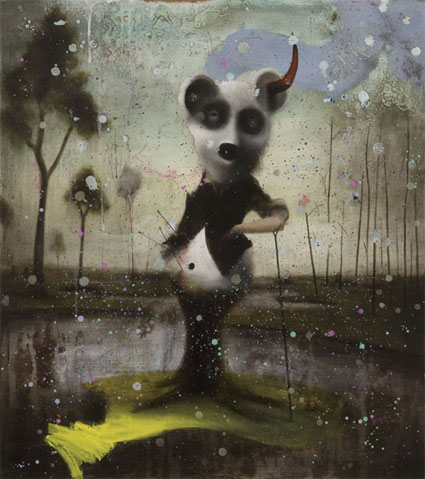
There is an end in flight, 2008
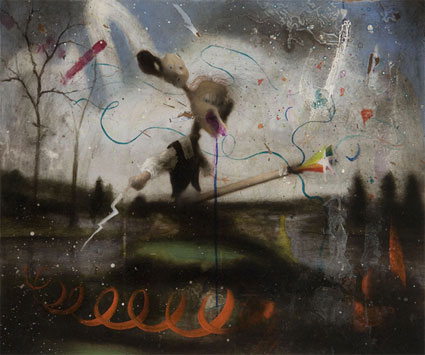
Trumpets of triumph, 2008
why on earth?, Anthony Pontius‘ solo exhibition at 31 grand closed on May 24 but i liked it so much that i can’t help mentioning it here. Pontius recontextualizes historical imagery, stories and concepts in the today’s world, mixes past and present techniques, and builds a universe which under some aspects looks familiar but is difficult to interpret and understand at first sight. The second sight doesn’t help much but that doesn’t prevent his paintings and studies from being utterly charming.
I’m back from New York for more than a week and getting ready for new adventures in little Europe. Time to turn a page on the transcontinental trip by throwing in a couple of posts the best exhibitions i saw while i was in Manhattan. Some of them are still up till the end of the month, others have already closed their doors. Here we go…
In the collective exhibition AMERIKA: Back to the Future, David Herbert, Anthony Goicolea, Marcus Kenney, Jennifer and Kevin McCoy play with American icons. The artists vision is somewhat dark, critical (how could it not be) but often humorous. Starship Enterprise is re-visited by future cavemen, Mickey Mouse goes on a size-zero diet and a burnt-down chain retailer’s suburban storefront aimlessly rotates on a plate.
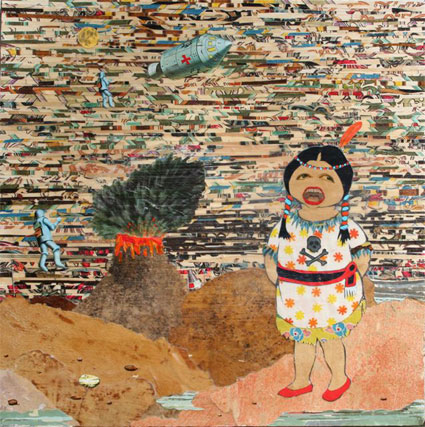
Marcus Kenney, The First Americans, 2006
My favourite by far were Marcus Kenney’s assemblage of discarded and old magazine clippings, book illustrations, old receipts, stamps, wallpaper etc. to create nostalgic imagery dealing with contemporary issues. The stars of his compositions are weird children, young women setting foot on distant planets or a girl walking on crutches painted with the motifs of the U.S. flag, etc. A closer look reveal the figures of U.S. presidents and American natives. The colourful and (at first sight) cheerful collages are hinting at some of the pages of American history which do not tend to make its citizens very proud.
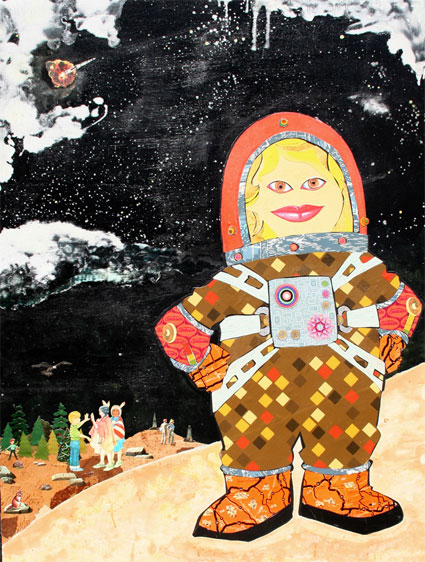
Marcus Kenney, Like a Good Neighbor, 2008
On view at Postmasters through June 21, 2008. More images.
I walked to the edge of the art Chelsea area to see Actus Reus, Tamara Kostianovsky‘s solo show. Ready to be butchered beef carcasses were hanging on hooks. Disturbing and so “life”-like that the gallery almost smelled of meat, the animals were made out of discarded human clothes.
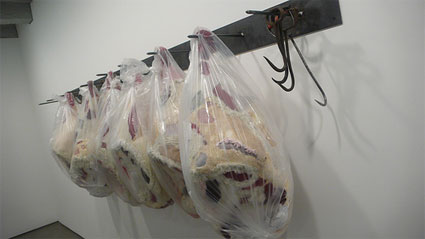
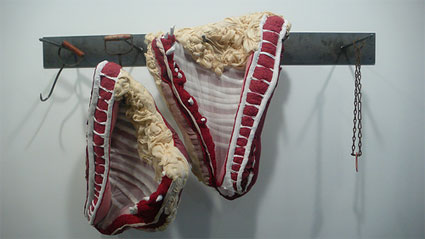
Actus Reus is the second part of The Proper Animal, a three-part multidisciplinary program comprised of three solo exhibitions by artists who utilize sometimes disturbing animal iconography to bring ethical considerations into play. The next episode, a show by Julian Montague, looks equally fascinating and as it will focus on spiders i suspect it will be equally repulsive as well.
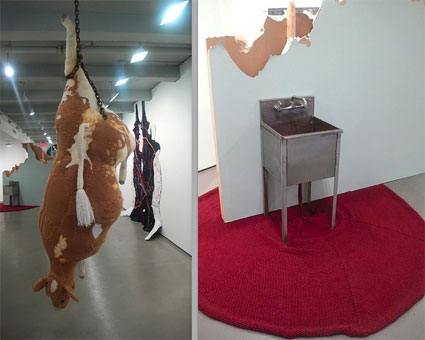
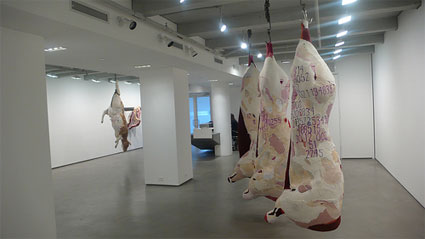
Closed recently at the Black and White Gallery, Chelsea. My images.
I got to discover the work of Dutch collective Antistrot by chance. I was in the building where they are having a solo exhibition to see another show. I happened to take the wrong corridor and enter the wrong gallery. That was for the best. Wild and powerful styles manage to cohabit almost peacefully on Antistrot’s paintings: animals you’d see on the walls of your favourite city, gangster faces you encounter mostly in fanzines, monsters like you’d get in a fairy tale without happy ending and busty girls being well… mostly very busty.
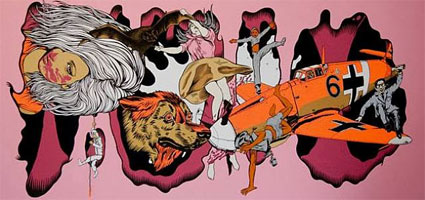
Ich Möchte Fliegen Können, 2008
Current members of Antistrot are Paul Börchers, David Elshout, Johan Kleinjan, Silas Schletterer, Michiel Walrave and Bruno Ferro Xavier da Silva, with additional help from Charlie Dronkers.
Video:
Antistrot from Saratecchia on Vimeo.
What we do is Secret is at Sara Tecchia Roma New York until June 21. My antiimages, also on artnet.
Shot in coastal waters and regions as far apart on every aspect as Australia, Japan, Antarctica, Kuwait, Iraq and California, An-My Lê‘s photographs examine intersecting themes of scientific exploration, military power, environmental crises, fantasies of empire and the vast ungovernable oceans that connect nations and continents.
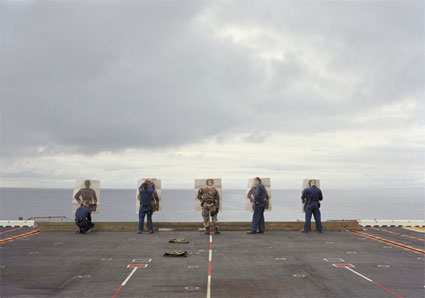
An-My Lê, Target Practice, USS Peleliu, 2005
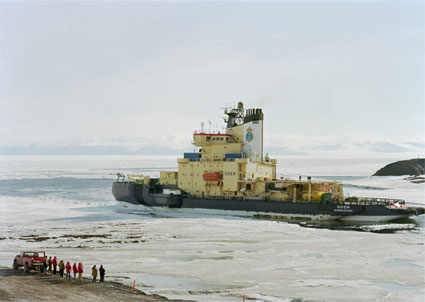
An-My Lê, Oden, Swedish Ice Breaker, McMurdo, Antarctica, 2008
Although the themes and settings are deeply grounded into reality, the images give an eerie feeling. The structures, military equipment, boats and landscapes captured by the photographer seem almost too big and out of this world to be true.
Seen at Murray Guy (the show is now closed)
Shuli Hallak‘s photographs document cargo in its state of transit between production and consumption. Almost every manufactured product humans consume spends time in a shipping container, yet most of us have little clue about the process by which goods are actually transported.

New York Container Terminal, 4, 2005
Fascinated by cargos, the photographer embarked on a container ship in New York and traveled to Florida, crossed the Panama Canal and ended the journey in Guayaquil, Ecuador to pick up some bananas.
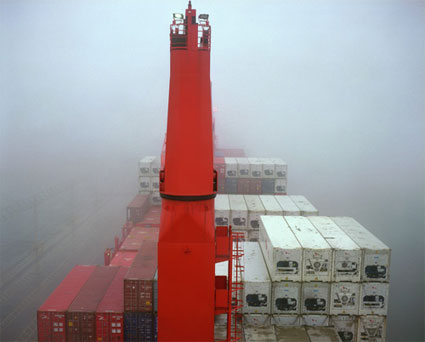
CSAV Chicago, 2005
On view at Moti Hasson through June 28.
It’s not everyday that Dick Cheney gives its title to an art exhibition.
In the weeks following September 11, the U.S. Vice President justified a steep increase of surveillance measures by explaining that “Many of the steps we have now been forced to take will become permanent in American life. They represent an understanding of the world as it is, and dangers we must guard against perhaps for decades to come. I think of it as the new normalcy.” Almost 7 years later, the collection and sharing of personal data by governments, luggage searches, Internet monitoring, and wiretaps have indeed become part of a “new normal” in American life.
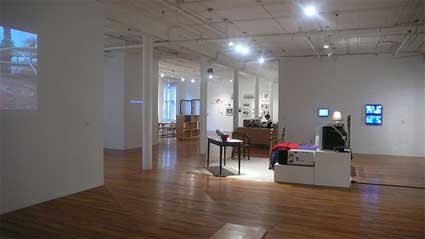
View of the exhibition space
The New Normal brings together thirteen artworks which explore private information. All the works have been developed after 2001, the year that ctrl[space] : Rhetorics of Surveillance, a major exhibition on privacy and surveillance opened at the ZKM center in Karlsruhe, Germany. It’s not a redux of the exhibition: new factors have changed the surveillance panorama since the ZKM exhibition opened. There’s President Bush signing the Patriot Act on October 26, 2001, the number and efficiency of technologies of surveillance have skyrocketed and we have come to accept the new state of “normality”.
The New Normal reveals how difficult it is to set clear boundaries around the concept of privacy. The private sphere encompasses domestic spaces, personal data, the content of your pocket, bodies, thoughts, communication, and behaviors–contexts that are usually rendered inaccessible to the public eye by legal, social, and physical boundaries.
What is most remarkable about the show is the subtle way it engages with the complex concept of privacy. The videos and installations do not hammer their messages on your head, you’re not told what to think and what to be very afraid about. Instead, the exhibition argues that today’s society is indeed living Cheney’s new normal life but this doesn’t meant that the new condition of public disclosure cannot be harnessed in the service of artistic endeavours and the creation of “tactics for political critique.”
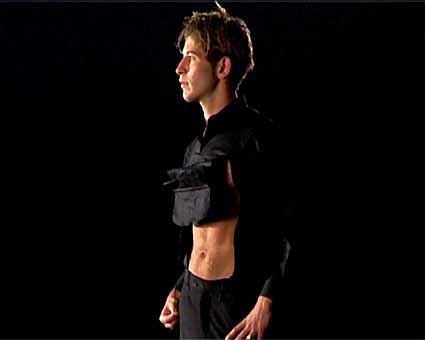
Videostill
Submitting oneself to security measures can be turned upside down by adopting what Hassan Elahi calls an “aggressive compliance”. Elahi daily points a mocking finger to absurd security measures with the real-time self-tracking website he set up in a bid to demonstrate to the FBI investigator that he’s not spending his time traveling to the Middle East and plotting some attack in the U.S. The models features in Sharif Waked‘s Chic Point Fashion for Israeli Checkpoints video seem to have adopted a similar strategy.

Videostill
Sharif Waked’s video features male models catwalking in clothes designed to expose the flesh of body parts such as chests and abdomens. It would be hilarious and cheeky were the images not juxtaposed with stills taken from recent years displaying Palestinian men having to lift their shirts, take off their pants and kneel shirtless in order to be authorized to cross Israeli checkpoints. The absurd pieces of clothing evoke the bodily humiliation experienced by Palestinians at Israeli checkpoints.
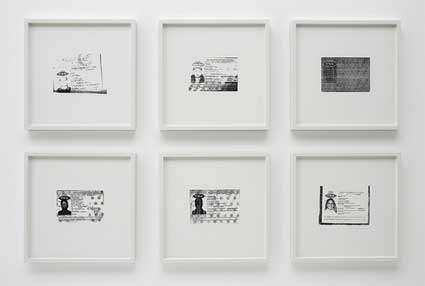
Six CIA Officers Wanted in Connection with the Abduction of Abu Omar from Milan, Italy. Courtesy the artist and Bellwether Gallery, New York
Equally politically-loaded is the series of badly photocopies of passports of CIA agents researched by Italian authorities in connection with the abduction of radical Egyptian cleric Abu Omar. On February 17, 2003, Abu Omar disappeared off the streets of Milan. The man had been kidnapped by the CIA, transferred to Cairo, where he was secluded, interrogated and allegedly tortured and abused. He was released 4 years later. The Imam Rapito (or “kidnapped Imam”) affair prompted a series of investigations in Italy.
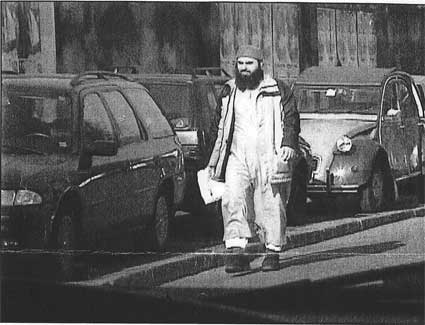
Twenty-six Americans were submitted to a trial in absentia along with several former Italian intelligence officials for their role in this case of extraordinary rendition. Trevor Paglen managed to get a copy of the photocopy of the fake passports that the agents had to deliver while they were checking in posh hotels in Italy in preparation for the kidnapping. The documents were released by Italian prosecutors in 2005. Although every element appearing on the identity document is fake, the picture had to be authentic. This ensured that the cover of the agents was blown and that the surveillance tools used by a government to achieve questionable goals can also become an instrument of justice.
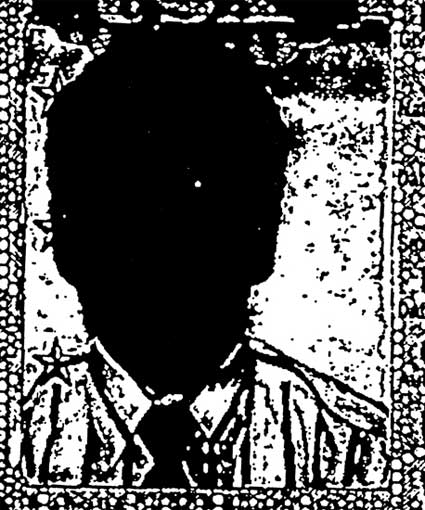
James Thomas Harbison (CIA Officer Wanted in Connection with the Abduction of Abu Omar from Milan, Italy). Courtesy the artist and Bellwether Gallery, New York
Relationships feed on bits of private information, it’s a currency we exchange with other people. Jill Magid‘s performance, photos and video Lincoln Ocean Victor Eddy not only illustrates this concept but it also put a human face on the surveillance we are submitted to every day.
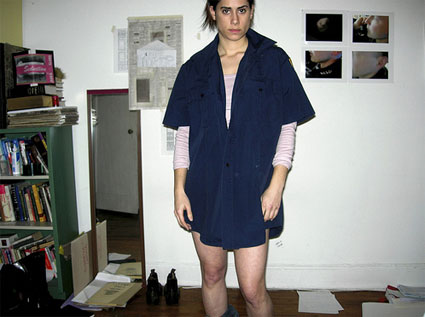
Jill Magid, His Shirt, Cropped (from Lincoln Ocean Victor Eddy), 2007. Courtesy Yvon Lambert Gallery, New York.
Back to New York City after five years spent in The Netherlands, Magid kept hearing this announcement in the subway “You may be a subject to searches “for security reasons”.” She approached a police officer and asked him to search her. He refused because only women officer had the right to search a woman but she managed to convince him to call her and tell her each night where he was on shift. She’d join him to be “trained” and kept record of the meetings in different forms: diary (read excerpts), photos, objects, etc. He would lend her his duty shirt, she’d give him a picture of her wearing it in return. She makes him tuna sandwiches, one day he allowed her to hold his gun. The relationship they build bit by bit is both intimate and somehow doomed: they are so different, the officer has never been to an art museum, Magid is “one of those liberals”.
Several works show that the intrusion into the private sphere is not just made of CCTV systems and biometric apparatus, it can also be voluntarily self-inflicted now that new online platforms called blogs, Facebook and image sharing call for self-disclosure.
As curator Michael Connor writes, Private information has never been less private.
The best example of this is probably the collection of videos that Guthrie Lonergan archived on you tube under the title MySpace Intro Playlist. Although they were made to be viewed by others, they convey an embarrassingly intimate echo once they have been decontextualized and exhibited in an art exhibition.

Developed by Michael Frumin during the 2004 Campaign in the U.S., FundRace is back. The website maps donation made to the candidates of the Presidential Election in the U.S. and enables you to search by name or address to see who your friends, co-workers, and neighbors are supporting. You can also search by profession and discover who celebs and museum curators are donating to.
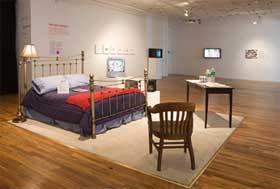 The revelation of famous people’s private requests almost makes you say thank you for a society which is so obsessed by the mundane facets of celebrities. Jennifer and Kevin McCoy‘s contribution to the exhibition is part of a series of sculptural displays of the products that musicians contractually require to be present in their dressing rooms after a performance. That’s where the loop closes and we get to cross path with Dick Cheney again. Band Rider Series (Dick Cheney) gives a glimpse into the very lack of spectacularity of Vice President’s desires when he travels to a new venue to give a talk: all tv sets have to be turned on FOX news, the hotel restaurant menu must be in his room along with bottles of water, etc.
The revelation of famous people’s private requests almost makes you say thank you for a society which is so obsessed by the mundane facets of celebrities. Jennifer and Kevin McCoy‘s contribution to the exhibition is part of a series of sculptural displays of the products that musicians contractually require to be present in their dressing rooms after a performance. That’s where the loop closes and we get to cross path with Dick Cheney again. Band Rider Series (Dick Cheney) gives a glimpse into the very lack of spectacularity of Vice President’s desires when he travels to a new venue to give a talk: all tv sets have to be turned on FOX news, the hotel restaurant menu must be in his room along with bottles of water, etc.
THE NEW NORMAL is a traveling exhibition co-organized by iCI (Independent Curators International), New York, and Artists Space, New York. It is on view at Artists Space until June 21, 2008.
Hasan Elahi at The Colbert Report:
Related: Sousveillance culture, Orwellian Projects, Book review – ctrl[space] : Rhetorics of Surveillance, Transmediale exhibition: Conspire, Trevor Paglen’s talk at Transmediale, etc.
There’s a mix pop art, cartoon aesthetics and ukiyo-e prints in the exhibition currently running at the Flomenhaft Gallery. But there’s also some dark pages from American history.
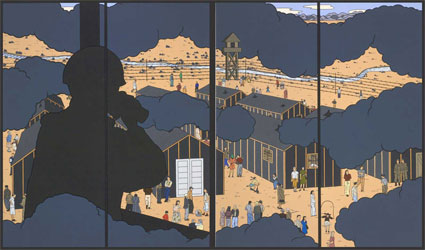
American Infamy #3
Born in Seattle in 1939, Roger Shimomura was two years old when he entered a Japanese American internment with his parents and relatives. Minidoka (Idaho) was one of ten hostile desert relocation centers. When Japan attacked the U.S. in the Pacific and World War II started, some 120,000 people of Japanese ancestry, 62% of whom were U.S. citizens, were regarded as suspects, spies and dangers no matter how long they had lived in the U.S. or how devoted they were to their adoptive country. It constituted the single largest forced relocation in U.S. history. Most of these camps/residences, gardens, and stock areas were placed on Native American reservations, for which the Native Americans were neither compensated nor consulted.
Roger was five when the Shimomura’s were permitted to return to Seattle.

Custom Homes (Suite of 5 paintings), 2007
To create the Minidoka on My Mind series, Shimomura had to collect scraps of memories from the back of his brain, consult archives and get some help from the diaries of Toku, his grandmother. For 56 years, from the day she left Japan to come to America until she died, Toku meticulously described daily domestic tasks and weather conditions in succinct phrases, sometimes despairing but never expressing anger.
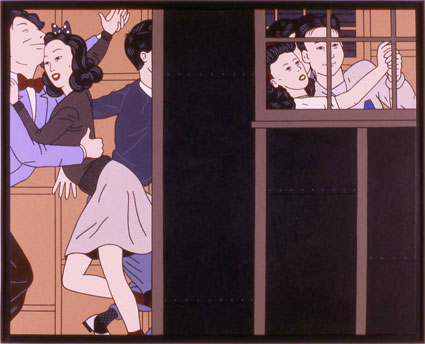
Block Dance, 2007
What makes the paintings striking is that the prisoners are dressed in what was (i guess) very fashionable in the U.S. at the time. Prisoners look very American, they do their best to get with a normal life while they are kept under constant watch by fellow (albeit whiter and carrying binoculars and machine gun) Americans.
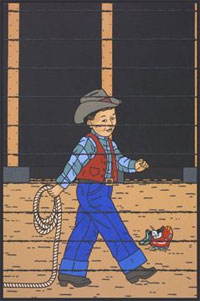 American Alien #4
American Alien #4
One painting, Not a J.A. (Japanese American) depicts a young guy called Ichiro playing baseball behind barbed wire. The Enemy #2 shows a young Japanese in traditional clothing smiling behind barbed wires. Block Dance shows a teenagers’ party, they dance and flirt but they are confined inside a stern barrack.
As a journalist of the Seattle PI commented, In an age of surveillance and a time of war, “Minidoka on My Mind” has relevance beyond its immediate subject. If you’re walking down a city street, chances are good some camera is tracking you. And no imagination is necessary to relate to the idea of a military operation hanging over daily life like a dark cloud or a term like “enemy alien” used to frighten people. Given the climate of xenophobia and suspicion that is taking Italy by storm these days (although in my personal experience there is nothing really new, being a foreigner in this country can definitely not be equaled to a long string of laughters), we need more works like Shimomura’s to remind us that fear might not always be the wisest adviser.
Image gallery, more pictures at Greg Kucera.
The exhibition runs until June 28 at the Flomenhaft Gallery, in Chelsea.
Although i tend to spend most of my time inside every single branch of Sephora when i’m in New York, i got to see some pretty interesting exhibitions while i was there. Daneyal Mahmood Gallery is hosting until June 14 an arresting installation and series of photographies by Justine Cooper.
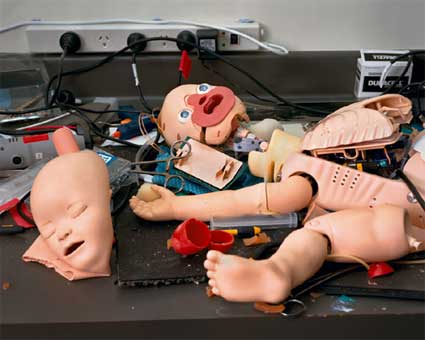
Sally, 2008
Cooper has an unquestionable interest for science. The Australian artist is known for having spent one year snooping around the storerooms of the American Museum of Natural History in New York.
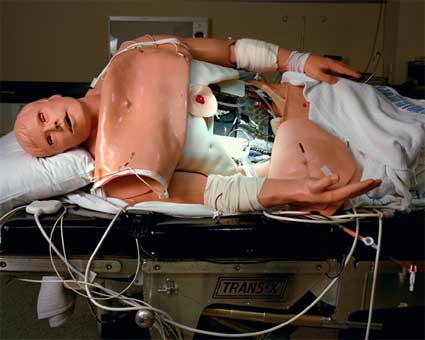
Charles, 2008
According to an interview she gave to Trace blog, the Terminal portraits she is currently exhibiting are inspired by the formal portraitists of the late 19th century and by the scientific work of Bernice Abbott. The stars of Cooper’s photographs are medical mannequins (just like Tomer Ganihar‘s hospital series) and robots. Highly sophisticated, they have been designed to simulate human traumas for training doctors and surgeons.
During her research, the artist found that the personnel charged with the care of the mannequins had humanized these objects into subjects by calling them Sally, Peter, Charles or Mandy. They dress them as if they were about to leave for the Bahamas and even construct a narrative through their care.
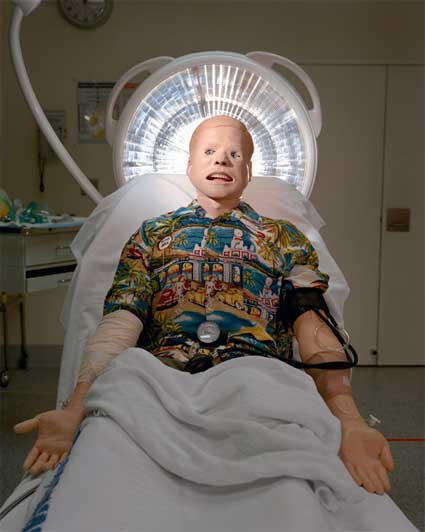
Peter, 2008
Also on show, RAPT I is a computer animation created 10 years ago from hundreds of images produced when Cooper voluntarily underwent six hours of MRI (Magnetic Resonance Imaging) scanning (video). RAPT II is a fascinating installation comprised of 76 of the MRI axial scans, printed on architectural film, suspended and aligned to create a 24 foot long floating body. I found very distressing the idea that i was able to pass my hand between the slices of her body.
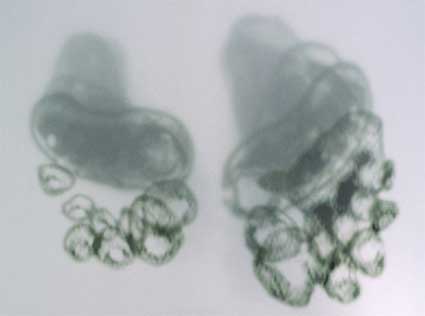
Rapt II, Detail, 1998
Rapt is what the artist calls a universal Self Portrait, originally posing the question of if and how new technologies shift the way we can conceive of space, by presenting us with an alternate, elastic interpretation of the body.. “Just as the body is re-codified through medical technology, so its internal spaces and brute physicality are remapped and made accessible in these works. Living flesh is translated into malleable data”
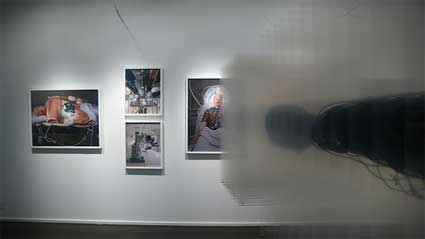
The exhibition is on view at Daneyal Mahmood Gallery until June 14, 2008.
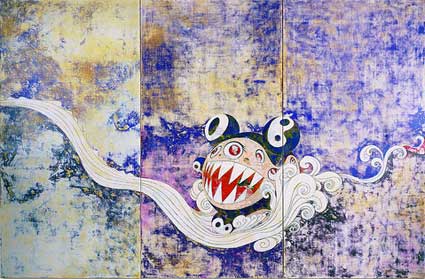
727, 1996. Courtesy of Tomio Koyama Gallery, Tokyo and Blum & Poe, Los Angeles. ©1996 Takashi Murakami/Kaikai Kiki Co., Ltd. All Rights Reserved
Is there anyone left in this room who doesn’t know how much i like Takashi Murakami (and his Kiki character)? Is there anyone who doesn’t like his work? Or doesn’t like to loathe its shallowness?
Now that i’m back in Europe (Yeah!), the usual programme will resume and start with Takashi Murakami retrospective at the Brooklyn Museum. I’m not going to bore everyone with a review of the show, just a few facts i discovered and images you’ve probably already seen everywhere.
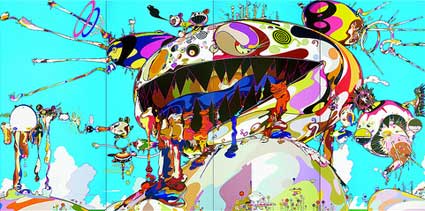
Tan Tan Bo Puking – a.k.a. Gero Tan, 2002. Collection of Amalia Dayan and Adam Lindemann. Courtesy of Galerie Emmanuel Perrotin, Paris and Miami. ©2002 Takashi Murakami/Kaikai Kiki Co., Ltd. All Rights Reserved.
– Murakami’s company/factory/collective is called Kaikai Kiki which means elegant or strange or bizarre phenomena. The term was used in the 16th century by critics to describe the work of painter KanÅ Eitoku as brave, powerful and yet keenly sensitive.
– Kaikai and Kiki are the pink and white stars of a new animation. They travel the world in a living spacecraft, watch as nasty monsters are turned into poop by a mighty princess and learn how to grow watermelons. Trailer:
– One of the reasons why Murakami is dubbed “the Japanese Warhol” is because he plays with the idea of blurring the commercial with the artistic. Not that he needs money to pay his rent, his Lonesome Cowboy sculpture recently sold at an auction for $15.1 million, nearly four times its $4 million high estimate. Aaanyway, Murakami did what even Warhol hasn’t done: he installed a fully functioning Louis Vuitton shop right inside the museum.
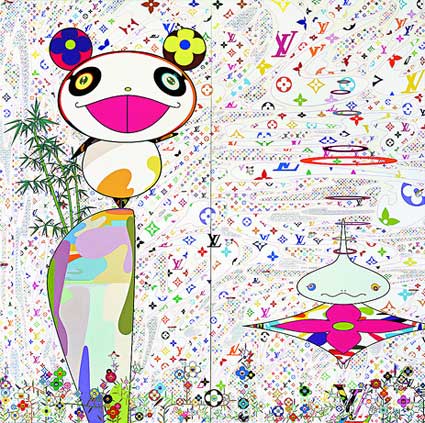
The World of Sphere, 2003. Courtesy of Marianne Boesky Gallery, New York. ©2003 Takashi Murakami/Kaikai Kiki Co., Ltd. All Rights Reserved
– The artist re-appropriated the LV logo in the painting The World Of Sphere in 2003.

Super Nova, 1999. Fractional and promised gift of Vicki and Kent A. Logan to the
collection of the San Francisco Museum of Modern Art. Courtesy of Marianne Boesky Gallery, New York. ©1999 Takashi Murakami/Kaikai Kiki Co., Ltd. All Rights Reserved
– The 18th century handscroll Compendium of Vegetables and Insects by ItÅ JakuchÅ« (detail) inspired the 7 panels of Murakami’s catalog of mushrooms. But the mushroom that most troubles Murakami is the atomic one.
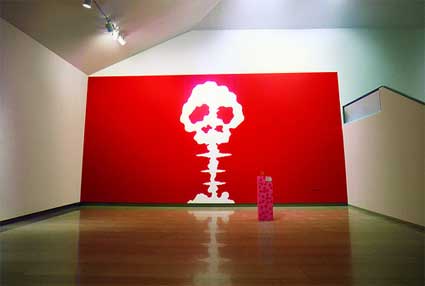
Time Bokan, 1993. Courtesy of the artist. ©1993 Takashi Murakami/Kaikai Kiki Co., Ltd. All Rights Reserved
– For a guy who siphoned classical painters, Disney characters, mangas and everything in between he is effing obsessed with copy rights.
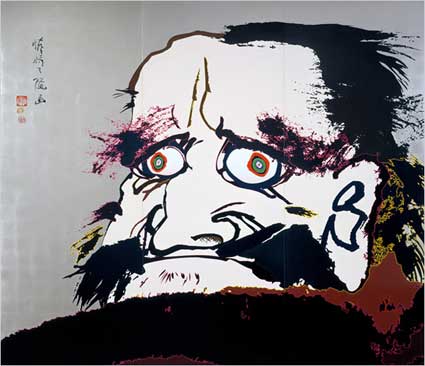
That I may time transcend, that a universe my heart may unfold (2007). Takashi Murakami/Kaikai Kiki Company, courtesy Gagosian Gallery
– Murakami has started making portraits. The museum is showing two paintings of r Bodhidharma, the sixth-century monk credited to have introduced Zen Buddhism to China.
There are numerous videos about Murakami on you tube, my favourite so far is this extract of one episode of Ben Lewis’ art safari tv series:
Followed closely by Jonathan Ross’ interview of the artist on Japanorama.
The New York Times has more images.
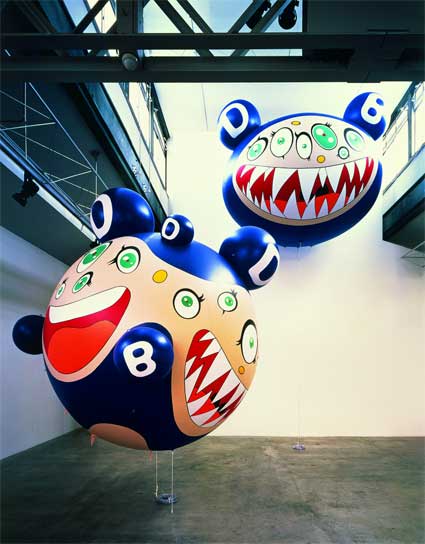
Installation view of Crazy Z, DOB’S MARCH (1995) and Forest of DOB (1995) at SCAI The Bathhouse, Tokyo. Photo by Norihiro Ueno. Courtesy of SCAI the Bathhouse,Tokyo; Galerie Emmanuel Perrotin and Tomio Koyama Gallery. ©1995 Takashi Murakami/Kaikai Kiki Co., Ltd. All Rights Reserved
The Takashi Murakami retrospective runs until July 13 at the Brooklyn Museum in New York.

White Nightmare (Sedan Chair), 2008
Yesterday i arrived in Manhattan just on time to see the last hour of Anton Kannemeyer’s solo exhibition at Jack Shainman Gallery. The title, The Haunt of Fears, comes from the 1950s EC Comics title, The Haunt of Fear, a bi-monthly horror comic from the ’50s. As co-editor of Bitterkomix, the satirical comic magazine he started with Conrad Botes in 1992, Kannemeyer became known for creating a new South African brand unconcerned with hypocrisy and political correctness.
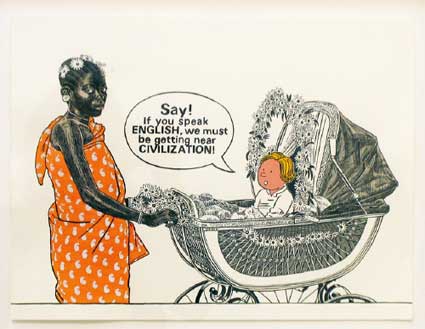
Say! If You Speak English…, 2008
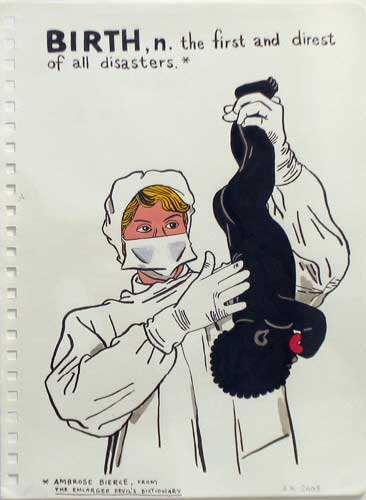
Birth, 2008
The gallery presented a selection of Kannemeyer’s works on paper from The Alphabet of Democracy-series, a new series entitled Cursed Paradise and drawings from recent sketch books; all of which raise extremely uncomfortable questions in the debate about racial stereotypes and South Africa cultural and socio-political landscape.
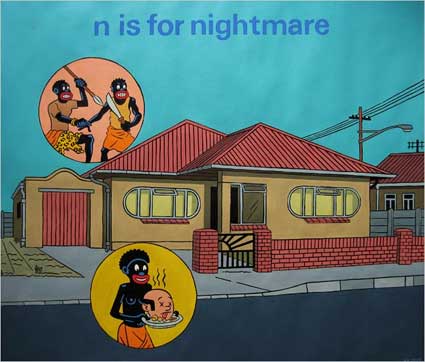
“n is for nightmare” (2008)
With The Alphabet of Democracy, the white South African artist tackles many issues politicians and journalists tent to “diplomatically” avoid. The series sharply comments on the madness below the surface of the rabidly conformist parts of white South African society, especially the Afrikaans community. Black politicians are not protected from his sarcasm either as the alphabet also targets the absurdity of some of their statements. However, some images from this series transcend satire. J is for Jack Russell, for example, shows a dog sleeping on the blanket with which its master’s murdered body has been covered.
In this context, the word “democracy” becomes subversive. The liberated South African society and its form of government are shown as just another arbitrary social order fraught with moral ambiguity and human absurdity.
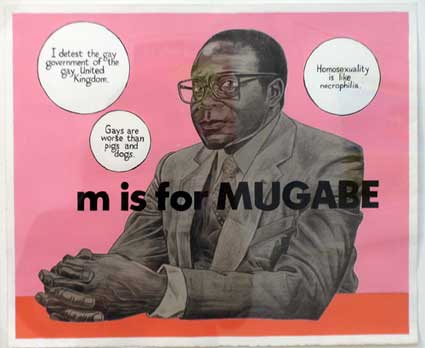
M is for Mugabe
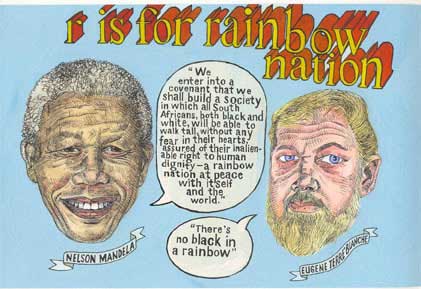
R is for Rainbow nation
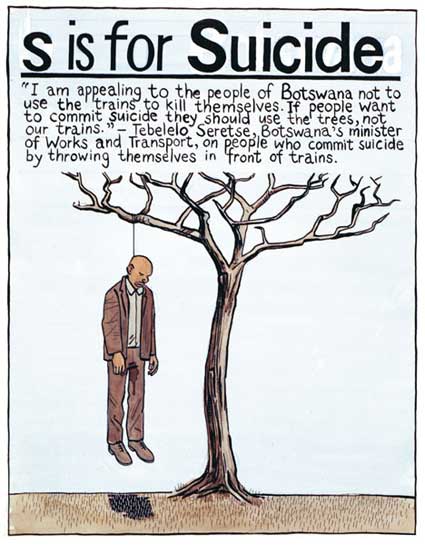
S is for suicide
In Pappa in Afrika, a parody of the controversial Tintin in the Congo, as a white African trapped in his own incriminating skin – a character who cannot escape his colonial past regardless of his personal political convictions. It depicts a content white man in a car driven by a black servant. A machine-gun-toting black soldier stands guard, while poor black natives watch the car filled with boxes labeled Texaco and Halliburton pass.
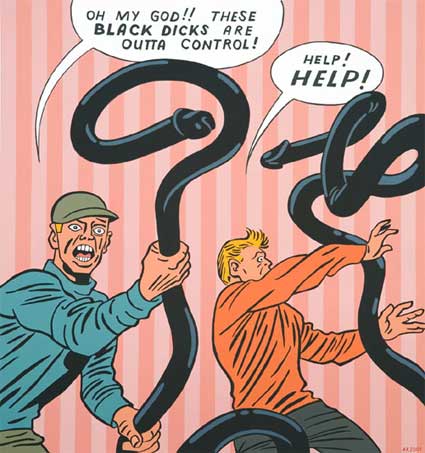
White Nightmare: Black Dicks
More images: Michael Stevenson and Jack Shainman Gallery.
First of all a little present. I’ve got one free pass for a reader interested in attending Mediabistro Circus which takes place in New York on May 20 and 21. The two-day conference focuses on the digital platforms and trends that are changing media today. Just send me an email (reg at this domain’s address) explaining why you’d like to go and i’ll forward the details of the most charming/desperate/convincing reader to the organizers of the event.
An overview of the programme: May 20: the publishing industry’s transition to new media, successful business models, blog power and finally video and social media. May 21: mobile media, the editor of digital news for the New York Times discussing the passage to online publication and user experience design (believe it or not i’m taking part to that panel!)
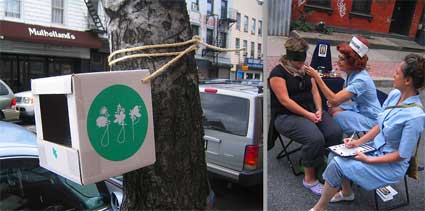
Scenes from the 2007 edition of Conflux
Next! One of my favourite events on this planet is Conflux, the festival of psychogeography which gathers artists, technologists, psychogeographers, urban explorers and experience designers from around the world in New York every year.
The organizers have recently opened their call for project. Deadline for submission is May 31.
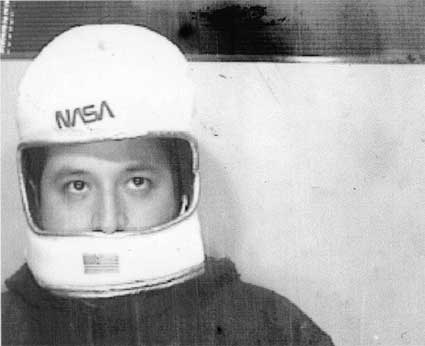
I’ve discovered Fernando Orellana in 2004, the year i realized that there were artists playing with technology out there. All along my tumultuous and whimsical 4-year relationship with new media art, artists have been appearing and disappearing from my BVBMA (Best of the very best media artists) list. I’m slowly moving away from the entertaining, the merely playful, the very geeky, the strictly techy and i’m now looking for something called “an artistic experience”. Well, Fernando’s installations are quite geeky in a sense and some are even playful but, no matter how you define art, i’ve always found something extremely meaningful and touching in Fernando’s work: a robot dreams, others are unable to make a decision, an elevator appears to be self-aware and a vintage radio relentlessly searches for God. Needless to say, Fernando’s work has always amazed me and i can see in my crystal ball that it’s going to be that way for the years to come.
The artist has uploaded several videos about his work on you tube. As a starter, here’s an ABC news segment on his robotic art piece “Sleep Waking”:
When i first met you in Gijon at the opening of the exhibition Emergentes, you told me about the personal story behind 8520 S.W. 27th Pl. v.2 (don’t miss the video of the robot assembly), an installation about the pointlessness of our never ending decision making process. Can you share it with the readers?
8520 S.W. 27th Place is the address of the home I grew up in Davie, Florida after my family moved from El Salvador in 1979. It is in a housing development called Rolling Hills. I’ve linked it in Google maps.
For the most part, my siblings and I assimilated and became part of American culture. Subsequently we grew up in the burgeoning suburban sprawl that has now swallowed southern Florida into an endless ghetto of cookie-cutter dream homes. This is what frames a large portion my childhood memories. Neatly cut lawns. Driveways with two-car garages. Manicured gardens adorned with transplanted trees. Swimming pool parties. Mosquito nets. Packaged people living out their packaged lives. Day in. Day out.
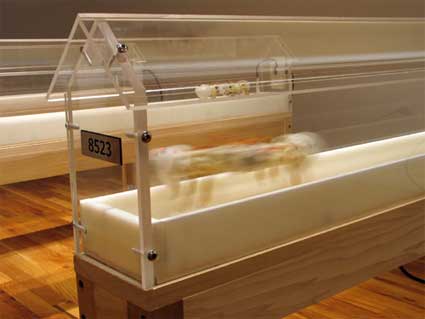
8520 S.W. 27th Place, 2004
This imagery is what fueled the aesthetic for this 8520 S.W. 27th Place. I wanted to reference the suburban dwelling that millions of other people worldwide grew up in as well. I thought it this would be the appropriate stage for a sculpture that speaks of humanities’ decision-making process. It is within the walls of these prefabricated, automated homes that we ceaselessly make decisions about everything; from the type of partners we want, to the garnishing on our pizza delivery, to what color we want our IPods. Endlessly. Back and forth. From the moment we are born till the day we die.
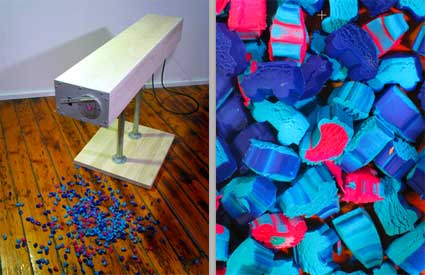
Extruder, 2008
How did you come up with Extruder? Where did you get the idea of making a machine that makes play-doh cars?
I arrived at the idea for Extruder from a couple different places. It branches from a series of drawing machines that I made a couple years back. Extruder started because I wanted to make a machine that could make sculpture. I had been doodling designs for this mechanism for years. I suppose funding issues kept them from materializing until now.
This last summer I made a series of paintings that spoke of war, dismemberment, IEDs, and automobiles. During that process, I came to appreciate the impact that the automobile has made on this world. I read a statistic that still baffles me when I think about it now. There is one car for every 11 people in this world, roughly 590 million passenger cars total. The automobile is involved in everything. From pancakes to penicillin, Play-Doh to parking lots.
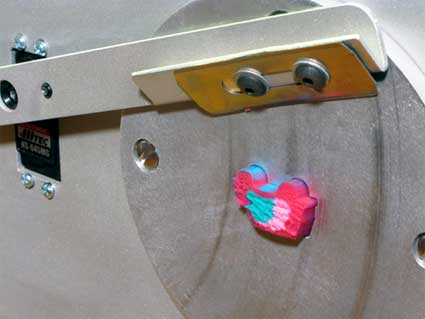
Extruder, 2008
I developed Extruder as a response to this machine that we worship. I wanted to celebrate it. Criticize it. Emulate it. Making hundreds of Play-Doh cars. Millions. The ultimate goal of Extruder is to make the total number of automobiles that were made in 1947 (the year Henry Ford died) by the Ford motor company, an estimated 429,674. As you can imagine that is also a whole lot of Play-Doh; about 11 tons. Until May 11th 2008, Extruder will be making Play-Doh cars at the Mandeville Gallery at Union College in Schenectady, NY. When the next venue emerges to exhibit it, the process will continue.
The colors that Play-Doh comes in were also a nice reference to my recent paintings. Vivid primaries and secondaries, suggesting the Technicolor cartoon reality that we in the developed world live in. Entertainment for the masses, delivered in candy-wrapped doses of violence, humor, and erotica.
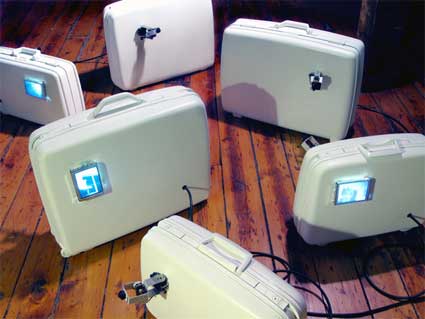
Carry On
The Carry On installation features a series of suitcases fitted with robotic arms and micro-cameras which survey their surroundings. Why did you feel the necessity to develop a work that explores surveillance and paranoia? How much impact on the public can artists have when they comment on surveillance technology?
Carry On is a direct reaction to post-September 11th paranoia, both in the USA and abroad. Since the attacks, I have traveled quite a bit. On these trips, I have passed through countless security and surveillance systems, always hunting for the would-be terrorist. Subway cars now display and sometimes speak “Report ANY Suspicious Activity”. If you happen to look even slightly of Arab descent, you may think twice about growing a beard or wearing your traditional garb. Leaving your luggage or backpack alone in an airport or a train station, even for a moment, could lead to a cavity search.
Holding a miniature video camera, on one side of each suitcase in Carry On is mounted a two axis robotic arm. The live video feed from this camera is displayed on a LCD screen mounted on the other side of the suitcase. Every couple of minutes, the robots change the position of the cameras, thus changing what is being displayed in the LCD screens. Lacking image analysis of any kind or other sensory capability, these suitcases blindly look about, never understanding what they see.
I’m not sure what impact artists make when they reference surveillance technology. Perhaps it may give a person a moment of peace or clarity. Realizing that, like the artwork in front of them, the whole affair of paranoia and fear based politics is an illusion; clever clockwork designed to create the reality they want us to believe in.
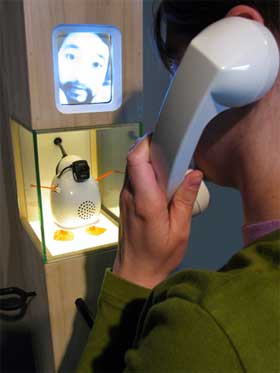 I saw that images of one of your recent project, Phoney. What is the work about?
I saw that images of one of your recent project, Phoney. What is the work about?
Phoney is a toy. It is a kind of absurd videophone. There are two terminals to the piece. The terminals are installed in separate parts of a gallery, with no line of site between them. Each terminal is fit with an old-school telephone receiver, a video screen, and a black and white camera attached to the head of a modified mechanical toy. When a person speaks into the telephone receiver of one terminal, their voice makes the mechanical toy on other terminal dance. This causes the video image they are looking at to shake, since the camera on the other side is attached to the mechanical toy. If two people are involved, a bizarre and sometimes funny conversation can commence. To me the piece references the countless methods or proxies that we now communicate through and the ridiculous information that we pass through them.
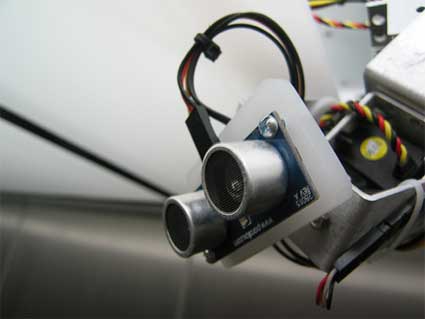
Elevator’s Music, 2007
I read that your work is about “creating systems that seem to be alive”. How much life is there really in your artworks? and how would you define such kind of life?
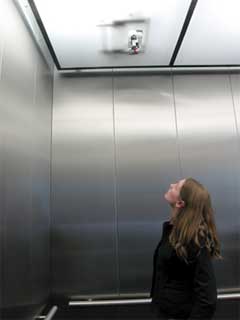 The key part in the quote above is this: “seem to be alive”. My machines are not alive. They never will be. I have become much more interested in the simulation of living systems. It is remarkable how easily we anthropomorphize things, especially things that are in motion. The perception of what humans will assume or believe to be alive is where much of my robotic work is headed.
The key part in the quote above is this: “seem to be alive”. My machines are not alive. They never will be. I have become much more interested in the simulation of living systems. It is remarkable how easily we anthropomorphize things, especially things that are in motion. The perception of what humans will assume or believe to be alive is where much of my robotic work is headed.
The latest iteration of this investigation is Elevator’s Music, a site-specific robotic sculpture that I exhibited in an elevator at the Tang Museum in Saratoga Springs, NY in the winter of 2007. It consisted of four small robots that emerged from the elevators translucent ceiling panels. When people entered the elevator, the robots would sense them and might emerge. Fitted with sonic sensors and having the ability to maneuver in three axes, they were programmed to seek out and respond to near and far objects. If a robot found something near by, it would try and interact with it via randomly determined mechanical gestures and a watery stream of sounds. The robot would also send a message to the other three robots (through a local network), informing them that it had found something of interest. This would cause all robots to look in the direction of the object, causing a kind of musical symphony to commence. If the object was somehow to close, or if nothing was found, they would recoil back into the safety of their ceiling panels.
With this relatively simple set of instructions the elevator robots were able to illicit innumerous reactions from their passengers. Some believed that the robots were watching them or trying to attack them in some way, while others became enamored with them, whistling and talking to them like one would to a pet bird. When one of the robots failed (as all robots eventually do), passengers reported it immediately to museum officials, feeling empathy for the hurt machine. Future robotic sculptures that I design will foster this tendency to assign anthropomorphic qualities to inanimate objects. Through this investigation I hope to arrive at more sophisticated and realistic artificial life simulations.
Video of “Elevator’s Music” at the Tang Teaching Museum at Skidmore College in Saratoga Spring, NY
What can technology developers or scientists learn from digital artists like you? Is there any reason why they should pay more attention to what crazy artists are doing?
I like to think they should pay more attention. In this country there is a general undervaluing of fine art and art education. Art departments all over the nation are the first to suffer from severe budget cuts. The argument that art is not a “mission critical” subject has dominated the establishment for decades. The problem with this of course is that students become completely illiterate to the visual culture all around them. In engineering and science I think this becomes a handicap. The engineer or scientist that can beautifully communicate their findings will undoubtedly fair better on the world stage. Moreover, those engineers or scientists that are willing to experiment with ideas that seem pointless or ridiculous may arrive at discoveries, innovations, and conclusions that otherwise might have eluded them. Perhaps “crazy artists” do have something to teach, other then just being dismissed to be irrelevant or a waste of time.
What is your favorite gadget or bit of technology and why?
It would have to be my laptop. I basically live inside it (or through it?). That aside, I have to say that I am a huge space technology nerd. I read everything and anything about space. Spirit and Opportunity, the two rovers scooting along on mars, or Voyagers one and two, speeding out of the solar system at this very moment are like aphrodisiacs to me. In fact I have a number of art projects that I am just waiting to develop specifically to be put into zero-g environments. Hopefully by the time I am retiring, this will be a possibility! In classic nerd style however, I would first need to over come the crippling and ridiculous sea-sickness I suffer from, sometimes even on sea-side docks.
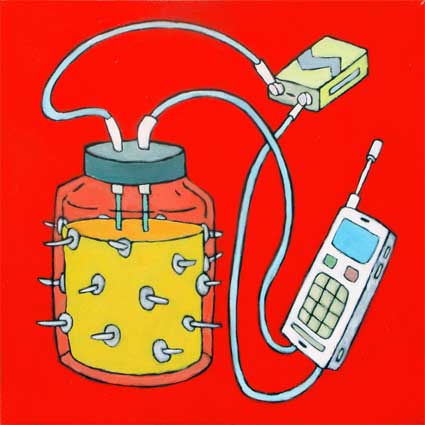
Nail Jar, 2007
What are the common factors between your media art installations and your paintings? Or maybe they have nothing to do with one another?
Painting and drawing is something I have always done. It was my doorway into art and in many ways it keeps me balanced. Until recently, the subjects I painted came from the schools of dada or surrealism, seemingly from my subconscious. This all changed in my recent work. Without really knowing why, last summer I started tackling the subjects I was exploring in my electronic sculptures in the paintings. Painting allows me to quickly approach different angles or points of view within a subject, some of which would not be possible in media sculptures due to funding or physical limitations. It is also a way for me to quickly explore new ideas, some of which are now leaving the canvas surface and becoming sculptures.
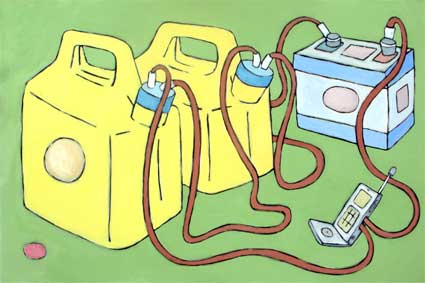
Gasoline, 2007
You are also developing an electronic art program at Union College in Schenectady, NY. Can you tell us what the highlights of the program are?
I was hired three years ago to help start an electronic art program at Union College. Our program is one of the few electronic arts initiatives that is jointly sponsored between the Computer Science and Visual Arts Departments. Drawing from aspects of The School of the Art Institute of Chicago and The Ohio State University’s Art and Technology programs (both of which I graduated from), we have created a thorough course of study, covering topics in digital imaging, video, 3D modeling, physical computing, experimental computer programming, web-design, interactivity, and animation. We have worked hard to make the program as cross-disciplinary as possible, offering courses that computer science, fine-art, and students from other disciplines can benefit from. In many ways the program was a perfect fit at Union College, since it has a long tradition of combining world-renowned engineering within a equally solid liberal arts education.
Any upcoming project or event you could share with us?
There are a couple projects cooking. The most imminent is a real-time video series titled Plain Text. The series plays on the “infinite monkey theorem” which states that given an infinite amount of monkeys, typewriters, and time, the monkeys will type out any particularly text you choose. If one instructs the monkeys (or monkey simulators), to type the King James Bible one of them eventually will. Interestingly, this also includes all the text that you did not choose or any text that might ever be written.
I apply a version of this theorem to a series of short phrases that over an extended period of time cycle through every possible permutation of themselves. For example the phrase:
“You want _ _ _ _ _ _.”
Starting right-to-left, like an odometer only with letters, all the blank spaces in the phrase sequentially cycle through every letter in the alphabet. By this, every word that is six characters long will eventually appear in the phrase above. Differing in theme, amount of blank spaces, and speed, each piece in the series has a different phrase displayed by itself on a large LCD screen.
 For the PluggedIn Exhibition happening in Hudson, NY from May 17th – 30th, two of these phrases will be on display in the vestibules of the Mark McDonald store, along with one large phrase projected on the store’s second floor windows.
For the PluggedIn Exhibition happening in Hudson, NY from May 17th – 30th, two of these phrases will be on display in the vestibules of the Mark McDonald store, along with one large phrase projected on the store’s second floor windows.
Thanks Fernando!
Yesterday i went to a very exciting show at Museum of Arts & Design in New York. Pricked: Extreme Embroidery has invited 48 artists to demonstrate the diversity of new approaches to needleworking technique.
As they did with their previous show Radical Lace & Subversive Knitting, the Museum demonstrates that contemporary artists are exploring new ways to bring centuries-old handcraft traditions into the 21st century.
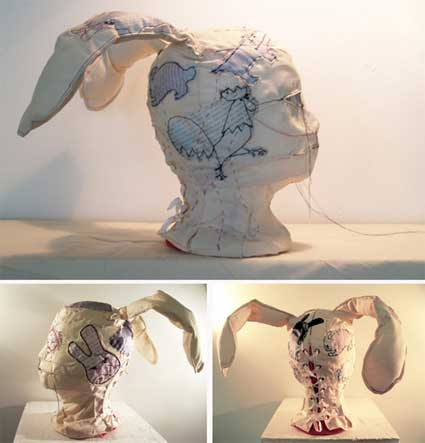
Phrenology III (child)
One of the works that most impressed me was Morwenna Catt Phrenology Heads. Phrenology, developed by German physician Franz Joseph Gall around 1800, and very popular in the 19th century, is a discipline which claims to be able to determine character, personality traits and criminality on the basis of the shape of the head (i.e., by reading “bumps” and “fissures”). Catt’s soft sculptures of heads have long animal ears, Frankenstein-like stitches all over their face, one eye is shut by a patch and a needle is stuck in their head as if the work was unfinished.
The heads are embroidered with fragments of texts: the Mother one has “You will need eyes at the back of your head”. The Father has “The gloom and the silence, i am terrified when i realise i am alone”, etc.
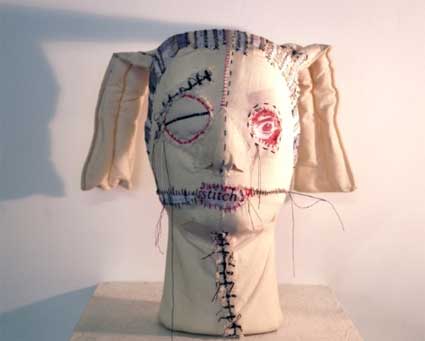
Phrenology head II, 2007
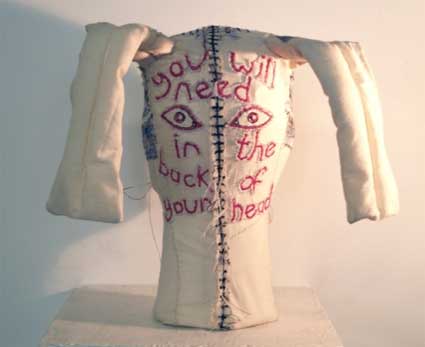
Phrenology head II, 2007
Words and images have been combined in traditional embroidered samplers for more than 500 years, and many contemporary artists give their own twist to the convention. Tilleke Schwarz, for example, embroiders texts and images she finds in her daily life from letters to editors that have caught her attention to images from television.
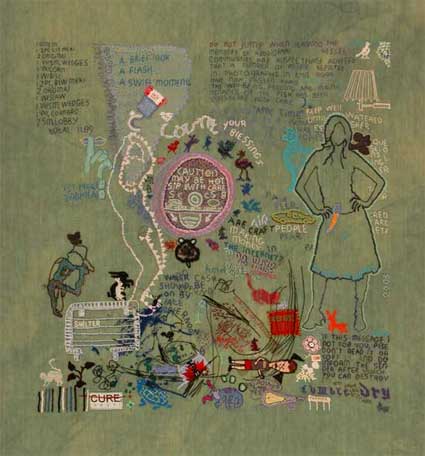
Tilleke Schwarz, Count your Blessings
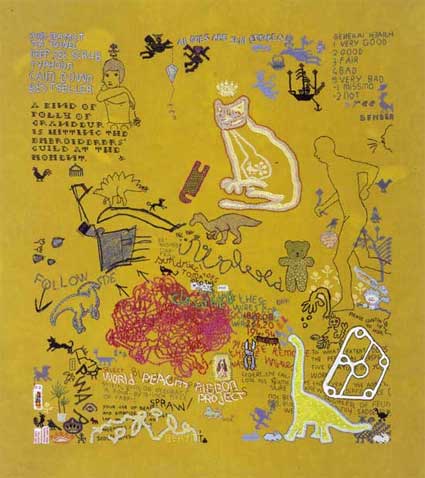
Tilleke Schwarz, Into the Woods
Elaine Reichek embroidered an 80-foot long transparent curtain with dots and dashes that spell out the first telegraph message sent by Samuel F. B. Morse on May 24, 1844: “What hath God wrought”.
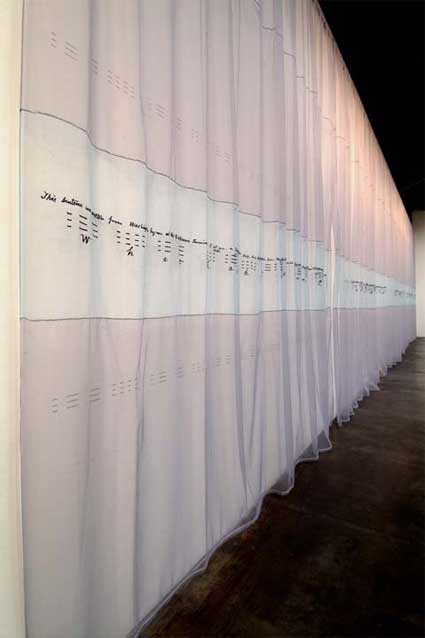
Elaine Reichek, First Morse Message
Andrea Deszö records aphorisms and warnings received from her Transylvania mother in the Lessons from My Mother series. 48 cotton squares are embroidered with illustrated bits of folk wisdom passed down from her mother: “My Mother Claimed That A Woman’s Legs Are So Strong That No Man Can Spread Them If She Doesn’t Let Him”, “My Mother Claimed That You can get hepatitis from a handshake,” “My Mother Claimed That Men will like me more if I pretend to be less smart,” etc.

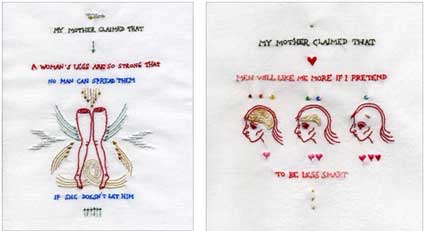
Andrea Dezsö, Lessons From My Mother
While embroidery traditionally connotes safety and domestic security, some of the artists in Pricked use the medium to explore and reflect on political and social issues.
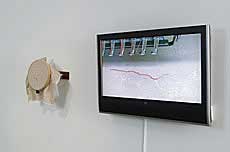 Mexican artist Ana de la Cueva‘s video shows a digital embroidery machine stitching the contours of the United States and Mexico highlighting the planned wall to keep out illegal aliens in bright red thread, all to the tunes of Mexican and American popular music.
Mexican artist Ana de la Cueva‘s video shows a digital embroidery machine stitching the contours of the United States and Mexico highlighting the planned wall to keep out illegal aliens in bright red thread, all to the tunes of Mexican and American popular music.
Ana de la Cueva’s video “Maquila” shows a commercial sewing machine stitching a white-on-white outline of the United States on plain cotton fabric, with a bold red line demarcating the Mexican border. Maquila refers also to the use by American manufacturers of cheap labor embroidery shops scattered along the border.
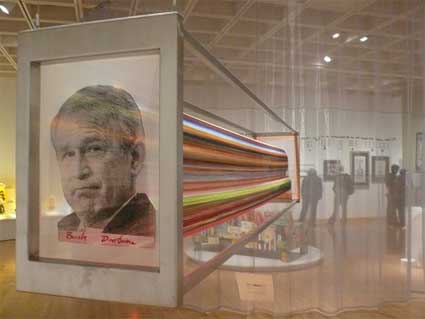
Xiang Yang, The Truth that People Are Not Willing To Face — Bushism vs Saddamism
Xiang Yang’s The Truth that People Are Not Willing To Face — Bushism vs Saddamism are portraits of President Bush and Saddam Hussein linked by a rainbow of threads. The threads are continuous between the 2 visages, giving the impression that the faces have morphed into one another.
Peter Hellsing used embroidery as a channel for communication with the immigrants who live in Flemingsburg, the suburb where he lives in Stockholm. He documented their stories of dislocation, alienation and longing for home on household furniture. The body of works, called A Little Cabin In the Woods, tells the story of these migrants, how they grew up in Sarajevo, or their fate during the Turkish-Armenian war.
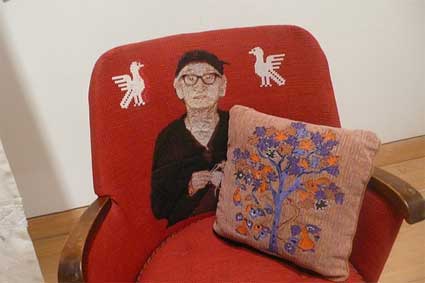
Peter Hellsing, A Little Cabin In The Wood (detail)
Sonya Clark‘s $5 bill celebrates the connection between the president and the Afro-American community by giving him an afro hairdo.
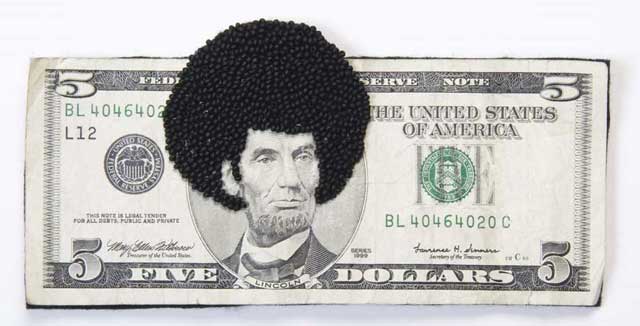
Afro Abe II, Sonya Clark
A section of the exhibition explores the work of artists who adopt, appropriate or quote images and ideas from other sources, including art history and popular culture, in their embroidered works.
Los Angeles-based artist Maria E. Piñeres embroiders portraits of celebrities who have been arrested, such as Mel Gibson and Robert Downey, Jr. Mark Newport has created a full-sized bed spread of embroidered comic books heroes as a way of exploring masculinity and identity.
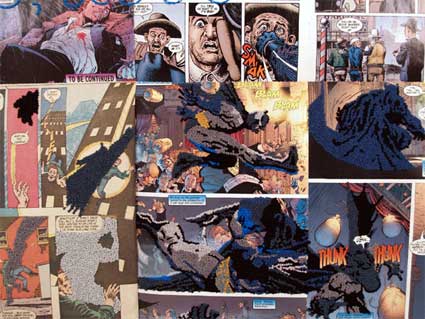
Mark Newport, Freedom Bedcover: Zachary
Paddy Hartley uses his research into the lives and families of disfigured World War I soldiers as the basis for his reconstructed military uniforms that are embroidered with texts and images related to the specific soldier.
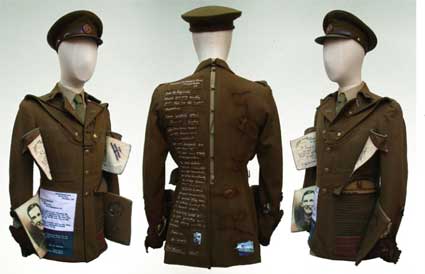
Paddy Hartley, Lumley
German artist Sybille Hotz created large-scale stuffed human figures drawn from first-aid manuals and medical books.
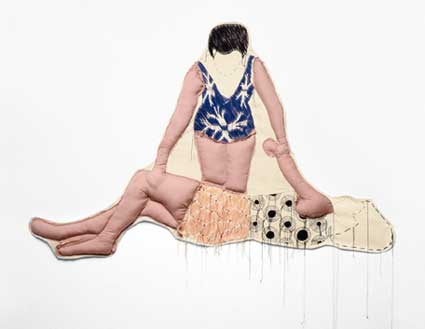
Sybille Hotz, Wenden
Orly Cogan embroiders found linens that have been previously embroidered with flowers, animals, and hearts with nude self-portraits and animal fantasies.
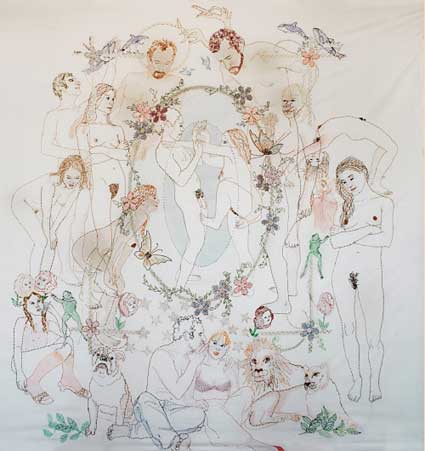
Orly Cogan, Second Nature
Laura Splan, whose work is at the crossroad between medicine and art, is showing Trousseau, an embroidered nightdress created from a transparent plastic-like material that results from a drugstore facial peel-off mask which picks up and retains the detailed impression of texture and hairs on one’s skin. She covered her entire body with the product, let it dry, peeled it off in one large “hide” so that she could have large sheets of “fabric” to work with. The sculptures are embellished with computerized machine embroidery.
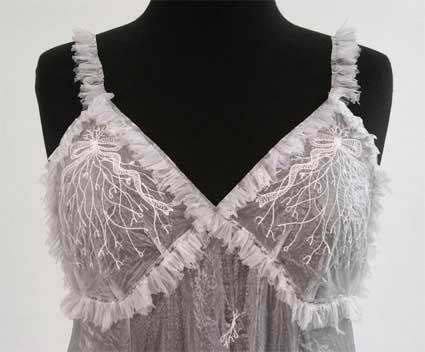
Trousseau (Negligee #1)
Splan has also turned the cellular formation of scary viruses such as SARS, herpes, HIV, and flu into doilies. They generate both a feeling of repulsion and one of attraction. Would we be willing to pass these dollies from mother to daughters as tradition would require?
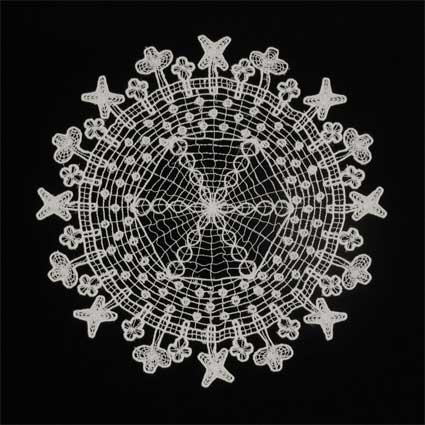
Laura Splan, Doily (Herpes)
Italian artist Angelo Filomeno, who learned embroidery as a child and today is a master in the form, has created a wide panel titled Death of Blinded Philosopher. It depicts a skeleton whose eye sockets have been violated by alaws, facing a blood red explosion of tendrils and blossoms attacked by flies and cockroaches.
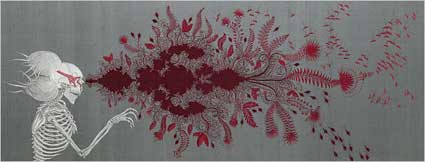
Angelo Filomeno, Death of Blinded Philosopher
Paul Villinski‘s wall sculpture Lament is made up of hundreds of abandoned or lost gloves collected from New York Streets, assembled as a massive pair of black bird’s wings which would perfectly suit Icarus.
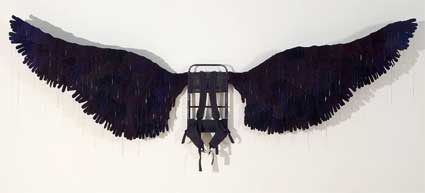
Paul Villinski, Lament
On view at the Museum of Arts & Design through April 27, 2008.
More embroidery: Subversive Knitting, Sandrine Pelletier, Divine Deviltries, Gales and Gasps, etc.
Back in New York for a few days and walking around Chelsea with a long list of shows to visit (as usual ArCal has helped me select them.)
On Friday i fell in love with the work of Marcel Dzama at the Gallery David Zwirner.
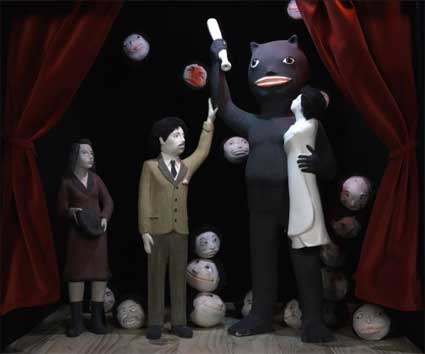
Fist Born 2007
Even the Ghost of the Past, Dzama’s fifth solo exhibition at the gallery, includes drawings, collages, costumes, installations, dioramas, and a film. They evoke fairy tales but with an added streak of terrorism, jazz-era nostalgia, sexual perversion and cruelty.
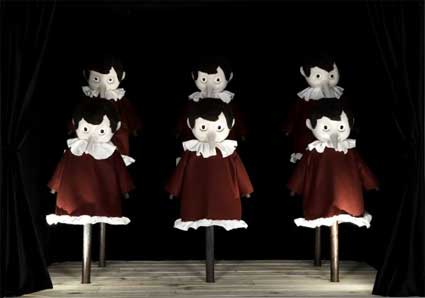
La Verdad está Muerta Room Full of Liars, 2007
Inspired by the religious shrines he found in Mexico and the work of Joseph Cornell, the Canadian artist has created a series of five dioramas. Recessed into the wall, they recall a child’s puppet theatre or the didactic displays found in natural history museums.

On the Banks of the Red River, 2008
Nearly 300 ceramic sculptures were used to compose the biggest diorama in the show. On the banks of the red river recreates the apocalyptic cover image of his 2005 exhibition catalogue, The Course of Human History Personified. Dozens of haughty aristocratic hunters, guns in hand, are massacring forest animals. The lovely fawn lays with its tongue out, the bird had its head severed from the body, the fate of the little dead frog leaves the hunters indifferent, bats and flowers are flying, etc. Great care has been taken to make the corpse as cute as possible. The cuteness of the animal kingdom turn into perversion with the Infidels diorama where adorable little bats flap their wings above a dead bear.
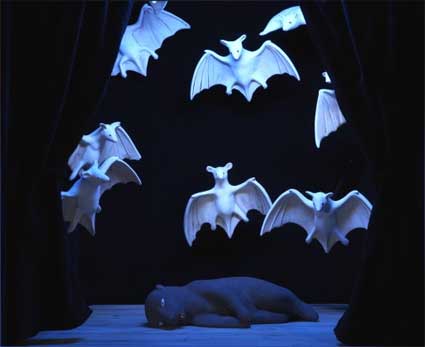
Infidels, 2008
Dzama also created an installation that pays homage to and almost demystifies Marcel Duchamp’s Étant donnés, 1946-66. Like Duchamp, Dzama has created an intricate tableau only visible to viewers through a peephole. The artist imagines what could have provoked Duchamp’s scene of a nude splayed in the woods. Dzama’s interpretation proposes a wily fox is to blame, knocking-out both the nude and her lover with a slingshot.
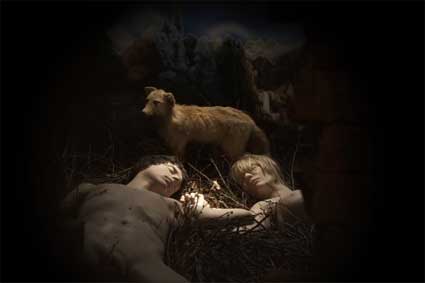
Even the Ghost of the Past, 2008
In a room at the back of the gallery, the silent film The Lotus Eaters recalls a time when black-and-white mute movies were accompanied by live pianists. The title suggests Homer’s mythical race whose favored food induced a dreamy and contented forgetfulness.
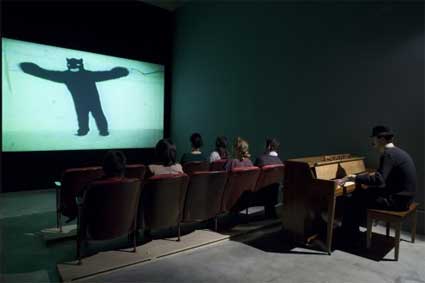
Lotus Eaters, 2005
Using a combination of 8mm and 16mm film, Dzama also incorporates footage shot by a Fisher-Price PixelVision camcorder – his childhood camera. Embodying the unique combination of homespun aesthetic and referential complexity that characterizes Dzama’s production, the film makes vivid not only the characters who occupy the artist’s imagination, but also the essential nature of the creative process.
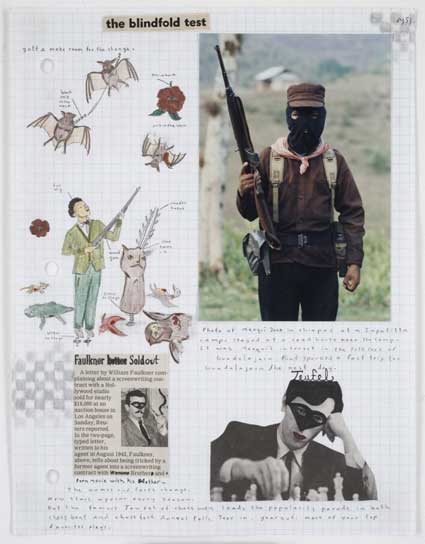
Untitled (Page 8 of 13), 2007
In Dzama’s drawings and collages, distinct characters take center stage against a blank background, most notably the masked and armed “terrorist.” The character is repeated amongst cowboys, archers, and femmes fatales. What the artist really meant to evoke is up to everyone’s imagination. It’s hard not to think of the climate of paranoia at the forefront of American politics.
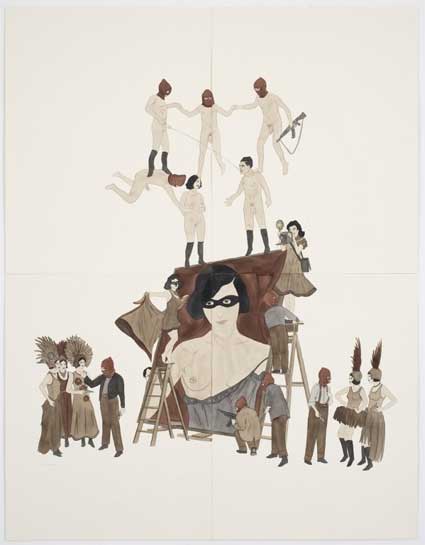
Weep our sad bosoms empty, 2007
More images. And i took some photos.
On view at David Zwirner gallery, through April 19, 2008.